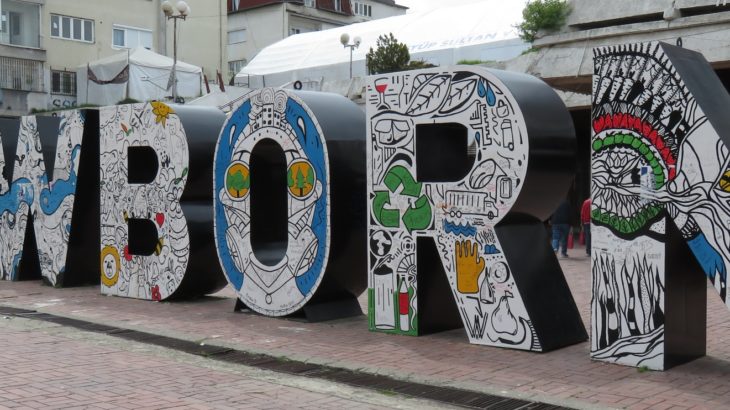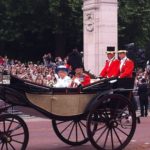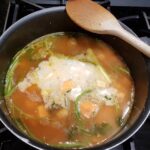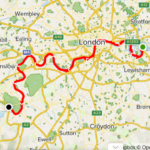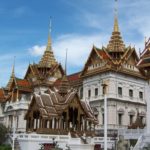Those old enough to remember Kosovo being in the news, around 20 years ago, will know of the conflict. Today, Kosovo is no longer war torn. Many cities are young and modern. Most places have recovered from those years of conflict but the past is still very raw. Located between Serbia, Montenegro, Albania and North Macedonia, a visit to Kosovo, in my opinion, is a must when in the area.
Having wanted to visit Kosovo for some time, returning to Albania to travel through the north was the perfect opportunity to cross over the border. It was really very interesting and probably a highlight of the trip. If you are curious like me, fancy something a little different, or in the area nearby then these are my recommendations when planning to visit Kosovo.
Need to know
Kosovo declared its independence from Serbia in February 2008 but it has only been recognised as independent by 102 nations and is not on the official UN sovereign states list. The majority of people are ethnic Albanian, although in some northern areas they are Serbian. Interestingly the official currency since 2002 has been the Euro.
Getting there
Flights from the UK are direct from Luton and depart 4 times a week. Other cities in Europe have direct routes as well.
It’s worth noting that you can enter Kosovo from Serbia, but you cannot enter Serbia from Kosovo unless you entered from Serbia initially.
Safety
We did not experience any issues, although it is advised to remain vigilant. The people are very friendly and as long as you are careful, all should be fine.
The FCO advise against all but essential travel to the municipalities in Northern Kosovo (Zvecan, Zubin Potok and Leposavic) and also to the northern part of the city of Mitrovica as there has been some violence there. However we visited Mitrovica, and it was certainly an interesting area, so perhaps worth risking to fulfill your curiosity.
Getting around
Hire a car or a private guide. Public transport is doable between cities but you will find it much easier to get to places out of the city with your own vehicle. If you need a recommendation I can certainly put you in touch with an amazing group of locals who can help.
Places to visit
The main cities, Prishtina and Prizren are good places to use as a base. It really depends on what you want to experience whilst there.
Prishtina
This is the capital and main international entry point.
As it’s possible to see most of the key sights in the city in just a couple of hours, you can take your time here. Of course I’d recommend taking a free walking tour (tips based) or a private tour with a local, as we did.
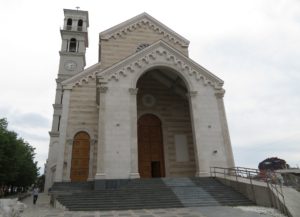
Cathedral of Saint Mother Teresa, Prishtina
If you plan to wander independently these are the key sights to consider, all doable on foot:
- Newborn monument – repainted every year and unveiled on Independence Day.
- Cathedral of Saint Mother Teresa – dedicated to the Albanian-Indian Roman Catholic nun and missionary.
- National library – metal cage architecture.
- Walking boulevard – cutting through the centre, the main route en-foot.
- Ethnological museum – 18th Century house.
- Market in bazaar – a great place to wander and experience local life; you can buy some of the freshest vegetables here, along with many other items.
- World famous people – if time permits take a short walk to George Bush Street and Bill Clinton Street. It’s worth checking out the Bill Clinton statue, where there is also a dress shop called Hillary’s. Tony Blair also features quite a lot in Kosovo, as he is considered a hero here.
Gracanica monastery
This is a site out of the city centre. We visited when a wedding blessing was in progress. There weren’t many people attending the ceremony and they weren’t dressed up but we felt like we needed to wait until they were finished before heading inside to admire the large frescos. A lot of the bottom section of the frescos have been destroyed and what remains has been patched with cement. However they are pretty spectacular.
Street Art
Street Art enthusiasts should head out of the city to Rruga B (Street B) where there is some 2km of wall along the side the road covered with the work of artists. The original work was the result of the Meeting of Styles event in 2017, but this has been expanded in recent years.
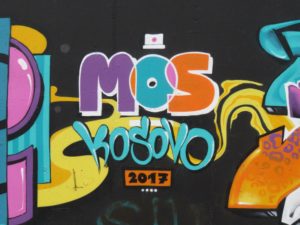
Meeting of Styles 2017
Prizren
The second largest city in the country. Even in the torrential rain, which we experienced when there in May, this is a beautiful city. With its cobblestoned streets and a steep trail up to the castle with an amazing view.
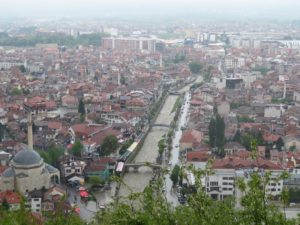
Prizren viewed from the castle
We took a walk with a local guide which covered off churches, mosques, the castle and the League of Prizren. All of this would be easy to see independently but its the local stories and interaction that brought everything to life.
Gjakova
Most famous for it’s lengthy bazaar of approximately 1km. The streets and buildings which replaced those destroyed in the war, create a trendy cafe scene. Cherry juice seems to a popular drink here along with the Kosovan macchiato.
This is also where I got to try out the embroidering of wedding dresses using traditional techniques. I’ll save the details and collate with my other creative travel posts another time.
Mitrovica
A divided city, with the promise of street art. The latter was one of my reasons for visiting, but of course my curiosity, having recently visited the Green Line in Cyprus, was looking for something a bit different to do.
First impressions was of a modern city, fairly busy and no sign of conflict. As we casually wandered over the bridge, the carabinieri military police didn’t seem to be bothered. Other than the blockade, the only sign of the the divide initially was the rather terse graffiti.
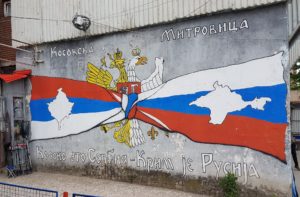
“Kosovo is Serbian; Crimea is Russian”
On the north side, the Serbian flags were overpowering, so the divide immediately became more obvious. As we wandered up the road, we could feel eyes on us, knowing that we didn’t belong there. The number plates on the cars were either missing or Serbian and many of the shops had signs in Cyrillic.
Once out of the centre, we wandered up to the Saint Demetrius church which was open but some what unwelcoming. The lady shook her finger at me when I asked it I could go up the stairs. So I just wandered around admiring the frescos on the walls and ceilings as well as the beautiful marble floor.
This was the worst we encountered, it’s perfectly safe to visit Mitrovica, in my view. Just be careful.
Prekaz
After visiting the divided city we had to head to Prekaz, to pay our respects at the site of the 1998 massacre, where KLA leader Adem Jashari was killed, along with nearly 60 family members. The devastation was unbelievable, not a place for the faint hearted, but worth stopping by when you visit Kosovo.
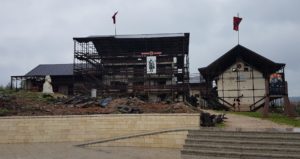
Prekaz, the Jashari family compound preserved after the massacre
Things to do
Wineries
Instead of one of the larger known wineries we opted for a local family wine tasting in the Rahovec region. The Daka family produces around 35,000 bottles a year and only supplies local restaurants. I was surprised at how much I enjoyed the chardonnay, as usually I only like the reds. The Vranac, a popular grape in the Balkans is an award winning product, but I personally preferred the Cabernet Sauvignon reserve. The Raki was also very good.
The vineyards of the Rahovec region are vast. Not how I would have pictured Kosovo before visiting. Make sure you try out the local wine when you visit Kosovo.
Kulla’s (Tower houses)
We spent two nights near to the village of Junik where we stayed in a converted tower house with home cooked meals. These Ottoman structures are scattered across the Balkans. There are several converted Kulla’s in the villages of Drenoc, where you can stay as well.
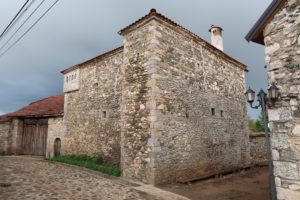
Kulla in the village of Drenoc
Hiking
It’s best to take a four by four out to the Gjeravica valley to hike. I was hoping to spot a few of the red sheep but it was too cold and with little grass, when we were there in May. The snow had started to melt, and the crocuses were starting to break through, so we settled for the fresh air and amazing views whilst hiking through the valley.
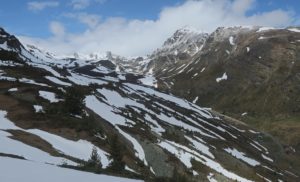
Gjeravica valley
Decani monastery.
We needed ID to get in here. The military check points seemed a little unnecessary on the road before we arrived, but this was the only current sign of conflict we experienced during our 5 day visit. There are many monasteries in the area but Decani is a must see when you visit Kosovo.
There are apparently more than 1000 faces in the frescos inside the monastery. We took a local guide who was well versed in the different saints, taking us through many of the pictures. We were also lucky enough to view the body of Stephani which resides in the casket in front of the altar. His body has been preserved. Thankfully we weren’t expected to pay our respects in the way the locals do (kissing the preserved blackened hand and cross) – we could just take a peek through the glass once the cover had been put back.
The monks at the monastery have been producing wine since the 15th century, so this is a good souvenir to pick up at the gift shop.
Other recommendations
There is a lot more to see and experience when you visit Kosovo, although we were limited on time. The above covers most of the highlights and a 5 day trip was adequate to get a little under the surface. If you have been to Kosovo, I would love to hear about any other recommendations.
